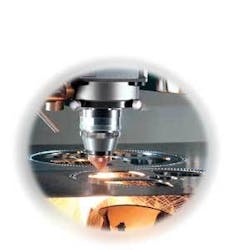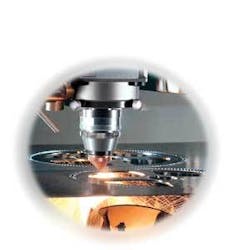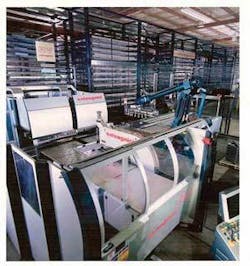A manufacturing paradigm shift?
Automation: applying transfer technology to moving parts as it relates to sheet metal fabrication
Elizabeth Kautzmann
American manufacturers, at any size organization from job shop to OEM, must be encouraged to further identify opportunities to drive down costs. It is essential for them to incorporate lean manufacturing and seemingly one-piece flow into their production philosophies. Truly the key to survival for many American manufacturers is diversification. Flexible Manufacturing Systems (FMS) are essential to curb the flow of business to off-shore services as more and more manufacturers decide to migrate production to facilities overseas.
The temptation to resist a genuine migration to lean thinking is great. It involves evaluating critical elements in process control and production style. Embracing automation has not come easily for American manufacturers. In the 1980s even Hollywood took a turn at casting stones with a reference to Hannah Arendt, a German American political theorist, in an on-screen play review during the film Beaches. The review applauded the probing assault on automation and industry, lending a suggested warning on the ensuing dehumanization of the American worker. Yet it is that very same technology, seasoned over 25 years, that offers hope to our present national condition.
The tremendous advantage of a FMS is the powerful reality of managing effort and time in order to deliver complex goods with less cost.
The ratio of labor-to-part costs drives manufacturing off shore-
Advantage: lower labor markets
However, even if both sides fully automate:
Reduced lead time, proximity and delivery shift the scales-
Advantage: USA
Automation is the essential catalyst that is necessary to rejuvenate American industries. Maximizing overall efficiency with automation reduces the off-shore leverage of lower labor costs.
Turning the tide
Reducing costs by identifying, reducing, and eliminating waste and by standardizing genuine value-added processes is FMS. The need for true FMS automation in sheet metal fabrication is already upon us. In the world of metal fabrication, lasers were late comers to the game, but with more than 30 years of continual product development and advancements lasers emerged as true contenders and are now considered by many to be a cherished commodity. With the implementation of high-speed linear motor technology, the notion, “You will never cut a hole faster than you can punch one!” was forever sent to the slogan bone yard. Some lasers boast rates of 500, 800, and greater than 1000 holes per minute. Phenomenal processing rates coupled with unrivaled flexibility; but what does it take to automate such a workhorse?
Is it possible to define a truly automated laser? Must the definition stop at automatic loading and unloading? Do we challenge the exclusion of laser cutting as it relates to FMS?
Automatic load/unload laser cutting systems balance raw material supply with stacking of unloaded parts and scrap. The disadvantage of waiting for a part until it is manually sorted forces a halt in true FMS flow. The nested objective of unloading and loading the system is to reduce the laser starve time. Starve time is known as any period in which laser processing could continue if additional material were introduced. Flow of production is interrupted by manual operations-wherever they occur. Successive operations must be delayed until manual removal of the piece. The part is more than likely laced within a web or skeleton of scrap. The true challenge is to have the laser only stop manufacturing during spark-to-spark transfers. Spark-to-spark time is the only time in the laser processing stream that cannot be eliminated; only minimized. Spark-to-spark time begins at the last spark of sheetcurrent and stops at the first spark of sheetnext: even a 20-second increase in spark-to-spark time can equate to 1000 sheets of a 4000-hour year on an average nest running at 8 minutes. Every opportunity to eliminate waste must be identified and managed. Manual part separation must be eliminated in order to have lasers ascend to the ranks of other FMS components.
Laser processing, by its very nature, is flexible, processing almost any vector geometry; it is WYSIWYG, what you see is what you get. For this reason, it is an essential tool in prototyping as well as full out production. The limiting factor remains the lacing of parts with scrap; after the laser cuts a part, larger interior and exterior scrap pieces remain on the table. Part sorting is necessary; without automation, true automation, separating and distinguishing the parts from the scrap interrupts product flow. Subsequently, the unloaded goods require not only manual separation but also manual identification, manual organization, and manual part count tally. To index to the following manufacturing process, the parts must be manually delivered.
The goal of companies that have embraced the new paradigm is to reduce or eliminate manual contact with the product-liberating their workers for assignments that require creativity and increased skill. Part sorting following laser cutting and prior to skeletal unloading is essential for truly integrating laser materials processing.
Managing and minimizing scrap and laser processed parts is the defining challenge between settling for a laser with load/unload or delaying decisive action until agent-of-change force influences otherwise. Confronting sorting and the challenges involved by implementing innovative software techniques and state-of-the-art retrieval units make laser sorting possible. Intelligent design of part sequencing and laser destruction cuts minimize or eliminate scrap interference points, thus lending full advantage to the automated sorting.
Clever and effective management of interior scrap and exterior skeletal pieces that may conflict with unloading in effect neutralizes the arguments against automation of laser cutters and exposes the fallacy of thought in limiting laser automation to merely loading and unloading without part separation. Talented engineers have fashioned features that translate the human experience of part separation into ‘instincts’ within the software; these dismiss the doubt and illuminate the expanding possibilities of laser cutting within lean manufacturing. There is no longer a need to postpone comprehensive integration of laser processing; part sort and selection of laser goods enables a process previously isolated from true FMS to be ushered into the collective arsenal known as the automated manufacturing system.
The companies following this path can reply to their lower-labor competitors, “Make the part cheaper…we’re making it smarter!” These same companies can devote energies to even further reduction in waste and non-value-add processes. The ability to steadily fortify a competitive edge by incorporating flexibility, reduced setup times, optimal inventory control, reduced WIP, and JIT delivery are the winds that fill the sails of today’s American manufacturers who find increased profits through lower costs.
Liz Kautzmann is product manager laser technologies for Salvagnini America (www.Savagnini.com).


